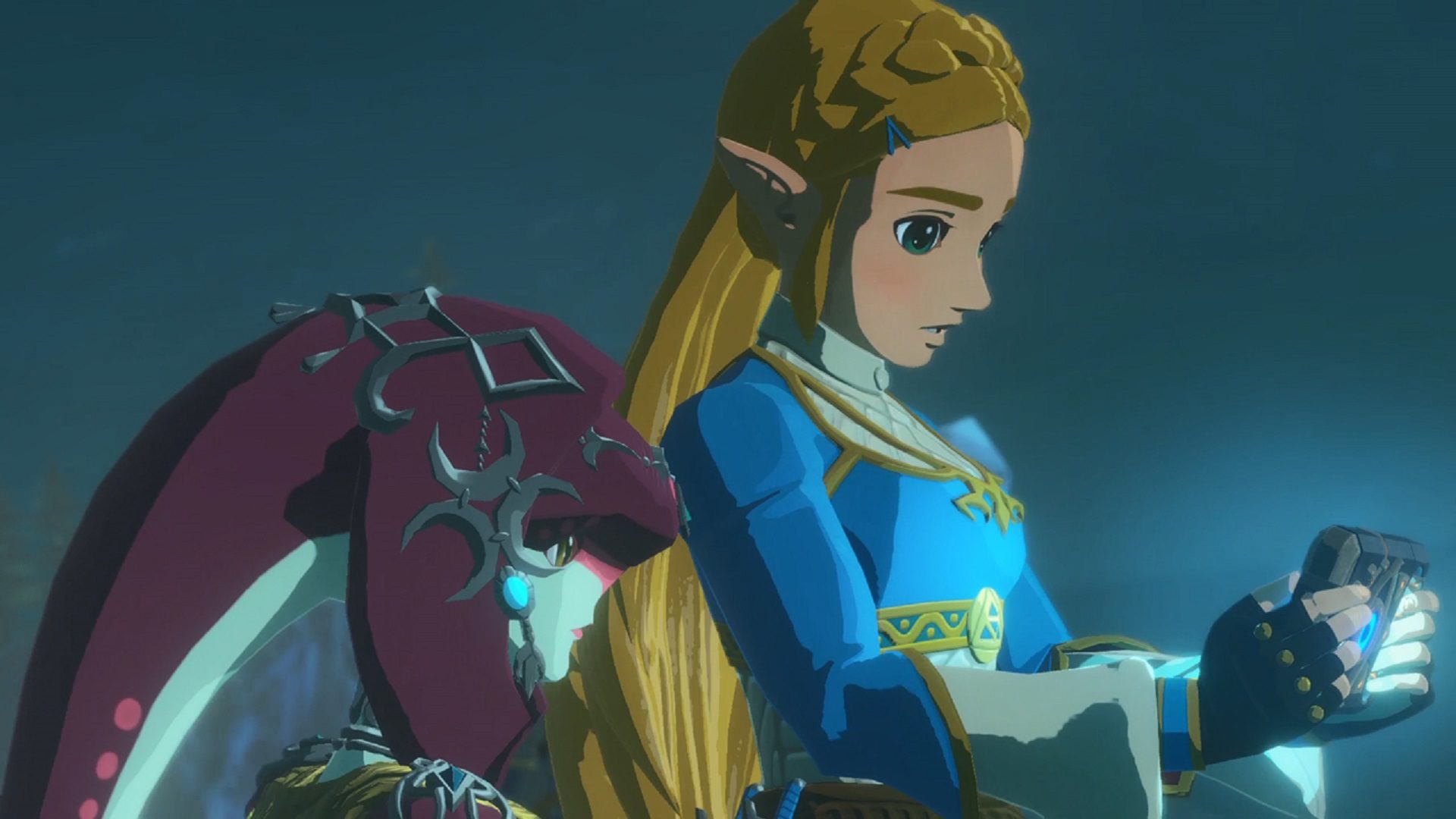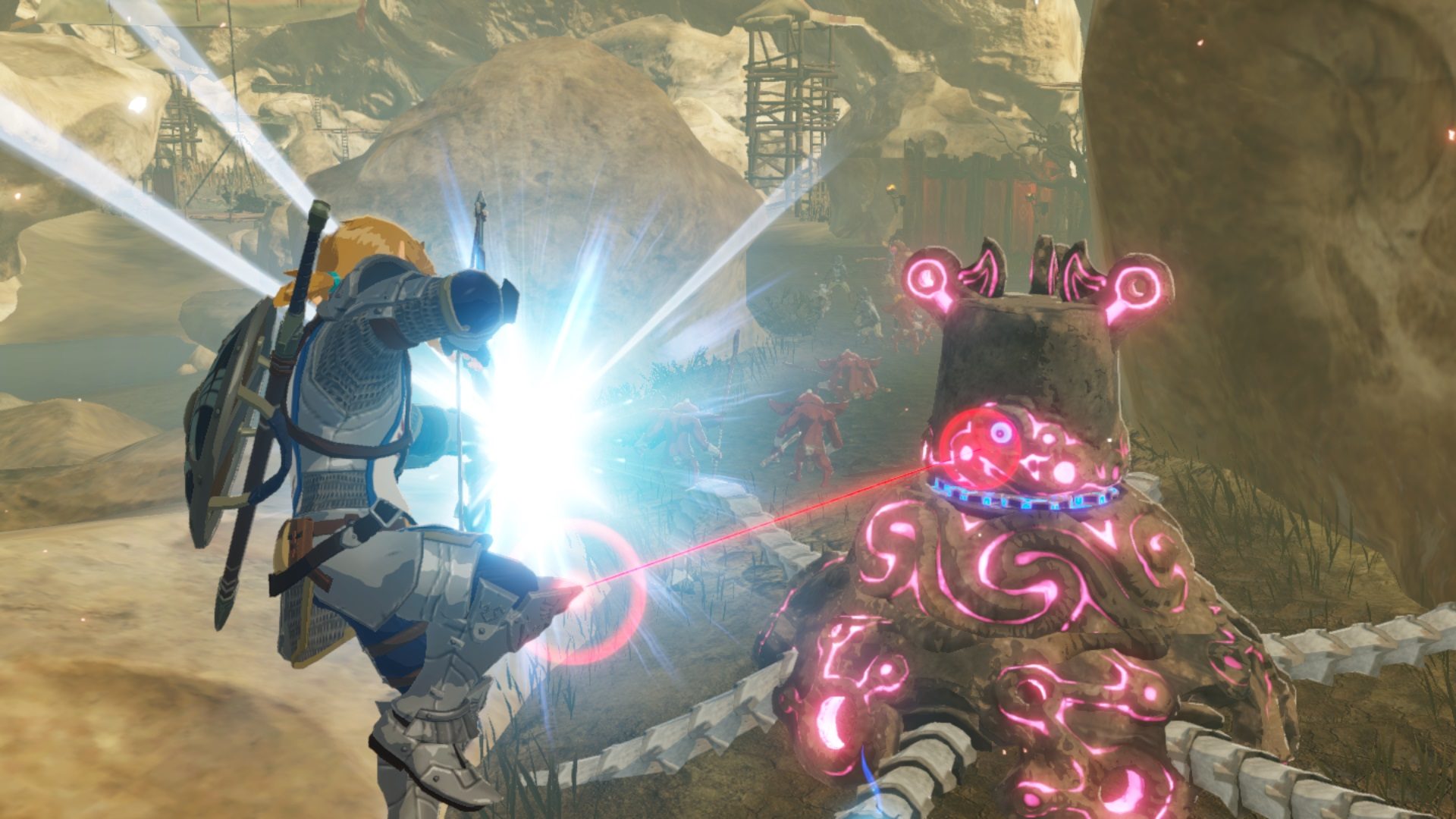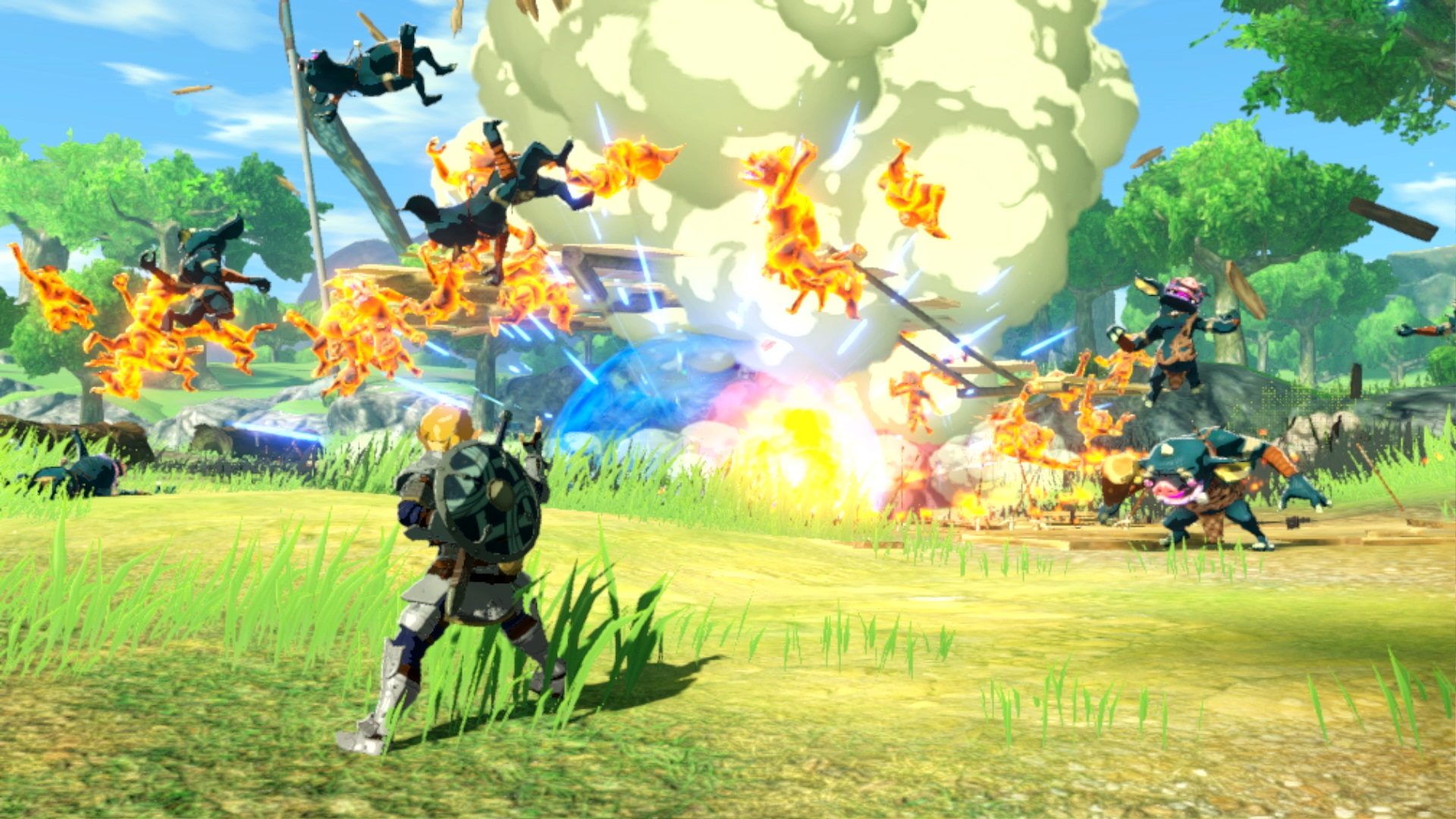Nintendo’s iconic characters are like the inverse of Matthew McConaughey’s character in Dazed and Confused. “Video games keep getting older, but we stay the same age.” That Mario, Donkey Kong, Kirby, and Link have remained so beloved and so recognizable in an era when some video games actually have fully fleshed-out narratives and character development speaks to the power of iconography and, of course, gameplay design.
This is most apparent in The Legend of Zelda, which has all the signifiers of an epic fantasy tale while lacking the foundation on which such stories are built. The convoluted timeline that sprung from Ocarina of Time, which attempts to cobble together a Frankensteinian continuity for the entire series, still hinges on a silent protagonist that has no discernible personality beyond literally being the personification of courage and doing whatever the princess tells him to do. And yet, that timeline exists, and fans crave that continuity because it provides a sense of meaning and purpose beyond “these games are fun.”
When we talk about Breath of the Wild and why it’s such a special game, we’re mostly talking about the open-ended nature of its gameplay. Many games like to consider the “sandbox,” but very few games live up to that label, and Breath of the Wild feels like one of the only action-based open-world games that actually does.
But there’s something else that’s still noticed but less touched upon, I think, that makes Breath of the Wild a standout Zelda title, and that’s its sense of history and narrative. Zelda, especially, is relatable in her struggle to live up to her father’s expectations, and her failure to do so in her initial battle with Calamity Ganon creates a redemption arc, with Link (and thus, the player) acting as her weapon in that crusade. Retaking the Divine Beasts, finding new Champions to pilot them, and retrieving the long-dormant Master Sword takes on a new flavor when you know you’re not just driving evil out of Hyrule, but also redeeming Zelda’s biggest mistakes and the undue pressure she faced from her father 100 years prior.

This is why I was so interested in Hyrule Warriors: Age of Calamity. I haven’t played a Warriors game since Dynasty Warriors 2, but the melding of Breath of the Wild’s unseen war with Warriors-style hack-and-slash gameplay seemed like a combination that suited both properties. Getting to see and participate in the moment when Zelda faced her biggest challenges also seemed to be tapping into the untapped potential of the series’ narrative.
Instead, developer Omega Force goes to a well that Zelda has gone to before: time travel.
If you’ve played the demo, then this isn’t breaking news. The story opens where Breath of the Wild’s story ostensibly begins—not with Link waking up from a century-long nap, but with Calamity Ganon defeating Zelda and Link at the end of the war. At the moment that evil wins, a miniature Guardian, doing its best R2-D2 impression, is activated and travels back in time to the beginning of the war to find Zelda and Link. That’s where Age of Calamity picks up.
One of the things that makes Age of Calamity so immediately likable is how closely it hews to Breath of the Wild’s visual design. You don’t get to appreciate Hyrule’s beautiful vistas like you do in Breath of the Wild, but everything about that game’s fantastic art direction is recreated to perfection in Age of Calamity.
It’s especially noticeable in the characters, from their outfits to their mannerisms, and it’s particularly satisfying to see these specific character designs take action in the context of Warriors gameplay. It’s one thing to see Link’s attack animations wipe out entire hoards of Bokoblins, but it’s another thing to see Zelda use the Sheikah Slate to do the same, or a young Impa and her shadowy clones cutting down a Hinox. The visual consistency of all the characters, enemies, and locations (at least as far as art style is concerned) helps create that narrative bridge between Age of Calamity and Breath of the Wild, which sells the fantasy that you’re fighting the mythical war against Calamity Ganon. Just like the game it’s based on, Age of Calamity never gets old to look at.

This extends to the UI as well. The menus, the map, and even the text are all holdovers from Breath of the Wild, and they all add to that same sense of continuity. I know that text and UI probably isn’t the most exciting thing about a game to most players, but I think those elements are especially important in Age of Calamity because Nintendo is all about attention to detail. To veer away from those elements would have made Age of Calamity look like a cheap spin-off, which it most certainly isn’t. These visual elements, maybe even subconsciously, sell the idea that Age of Calamity might not be a mainline Legend of Zelda, but it’s still a Zelda game, and “Zelda” generally translates to “quality.”
The other, more important way that Omega Force sells its fantasy of hacking-and-slashing your way through Breath of the Wild’s Hyrule is how cleverly it translates that game’s different gameplay elements to its Warriors formula.
Of course, every character has their basic light and heavy attacks that are all adapted based on the characters’ inherent skillset. Link—whether he’s using a sword and shield, a spear, or a two-handed weapon—attacks in the way that you’d expect, with a series of slashes, stabs, and his iconic whirlwind slice. The Zora Champion Mipha, meanwhile, has attacks that seem more appropriate for an amphibious hero, including a special ability that creates a geyser which she can use to quickly get behind groups of enemies.
Despite their attack combos all requiring the same button inputs, every character feels like they have their own identity and individual style in combat. That’s partly due to the different weapons that each hero brandishes and how they feel like their Breath of the Wild counterparts, but each character also has an ability tied to the ZR trigger that completely changes the way they play.
Impa, for instance, can mark enemies with symbols and then absorb them with her heavy attack to create her clones, which she not only needs to fill up her special attack meter but also mimic her every move, including her attacks. Revali’s ability launches him into the air, from which he can rain down arrows. Urbosa can charge up and store electricity and then unleash it with a series of devastating attacks. When the core gameplay starts to get repetitive, you can just jump to another character and have a completely different experience. And thanks to the Military Training Camp, you can spend rupees in order to level up characters that you might have neglected.
Gameplay elements more specific to Breath of the Wild are also cleverly integrated. The four main runes of the Sheikah Slate—Bomb, Stasis, Magnesis, and Cryonis—are tied to the R bumper and are particularly useful in countering boss attacks. These attacks conveniently telegraph which rune to use, though you only have a small window to activate these abilities even while being able to slow down time by holding R. Utilizing the right rune at the right moment is incredibly satisfying.
The Flurry Rush and parry mechanics work exactly as they do in Breath of the Wild, and you can also use them to quickly turn the tide of a battle by opening up bosses for devastating counter attacks that whittle away their posture meters. Completely break their posture and you can perform a weak-spot attack, which takes away a huge chunk of their health bar. It’s not necessary to perform these maneuvers to whittle away at the enemy’s posture, as simply dodging an attack that leaves them open will do the same, but they lend a sense of skill to the patently simple Warriors hack-and-slash experience.

All of these translations from Breath of the Wild’s gameplay to Age of Calamity’s formula make for a consistently fun experience, though that’s not to say that the game doesn’t get repetitive at moments, even if you are switching between characters. The other half of the Zelda series, which is its puzzle-solving, is conspicuously absent, and after a while you will have defeated every enemy type countless times. Near the end of the main campaign, I began to feel that the game was overstaying its welcome, especially as more icons—whether they were simple character unlocks for more hearts and combo extensions or smaller skirmishes that let you gain experience points and farm for upgrade materials—began to dot the map. The good news is that, if you never get bored of hacking and slashing, Age of Calamity is constantly giving you excuses to partake. But if you’re simply playing for the story, you might hit a wall 20 hours in.
All told, Hyrule Warriors: Age of Calamity is one of the most fun games I’ve played all year. Still, it’s impossible to fully express my opinions on it without risking spoilers and, thus, the ire of both eager fans and Nintendo itself. What I can say (I hope) is that its narrative direction feels like a cop out, but that doesn’t mean it was entirely unsatisfying. Instead of deepening the source material, it convolutes an already convoluted timeline. Whether it’s canon or not is a pointless question, when the Zelda canon is already so malleable and paper thin. Mostly, it feels like a missed opportunity for Nintendo, which both published the game and worked closely with Omega Force in its development, to grow up a little bit.
On the other hand, the reason that Nintendo remains so near and dear to so many gamers is because it refuses to grow up. Sometimes this backfires, like with the utterly disappointing Super Mario 3D All-Stars collection, but often it means comfort in knowing what you’re going to get, which are the same characters starring in iterations of the same high-quality gameplay and attention to detail that Nintendo has consistently delivered for decades.

Images: Nintendo
|
★★★★☆
Hyrule Warriors: Age of Calamity ingeniously translates The Legend of Zelda: Breath of the Wild’s world, style, and gameplay into the Warriors formula, and fans of both series will be extremely satisfied with how both are reimagined here. But if you were expecting a more straightforward prequel that truly mined the tragedy of the war against Calamity Ganon, instead of relying on tired tropes like time travel, you might be left a little shell-shocked. |
Developer Omega Force Publisher Nintendo ESRB T - Teen Release Date 11.20.20 |
| Hyrule Warriors: Age of Calamity is available on Nintendo Switch. Primary version played was for Switch. Product was provided by Nintendo for the benefit of this coverage. EGM reviews on a scale of one to five stars. | |

Michael Goroff has written and edited for EGM since 2017. You can follow him on Twitter @gogogoroff.